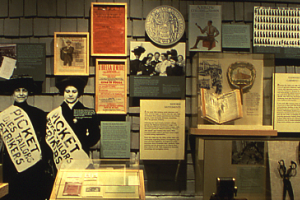The Well-Rounded Lesson: History and Common Core Math Come Together As Teachers, and Students, Collaborate

Try this teacher-created lesson on OER Commons: “Cross Curricular Approach to the Child Labor Practices of the 1800s and 1900s Industrial Revolution”
Teachers embodying instructional leadership—this is the ultimate goal driving ISKME’s work bringing teachers together across subjects to support each other’s professional learning around Common Core instructional shifts. ISKME’s project, Teachers Advancing Common Core Learning, supported by the Bill and Melinda Gates Foundation as part of their Teacher Practice Networks initiative, assists cohorts of three teachers, one each from ELA, math, and either social studies or science, to work together to align learning to Common Core literacy standards, and to develop student skills related to inquiry and building evidence across the disciplines.
The cross-curricular collaborative approach is facilitating change in teaching practice, with the focus on increasing student engagement with core content and building close reading, inquiry, and critical thinking skills. What we have observed among the participating teachers is engagement with openly available resources, the creation of their own original lessons from a deeper familiarity with the intentions behind the Common Core standards, and a strengthened commitment to sharing and collaboration with peers across subject areas.
Collaborating on Integrated Lessons
Shelley Arca, social studies teacher at Horner Jr. High in Fremont, CA, is a teacher participating this cross-curricular project. Shelley’s two colleagues, Navpreet Bedi, ELA teacher, and Victoria Birbeck, math instructor at Horner, jointly constructed an integrated lesson and set of classroom activities, described by Shelley:
"When I found out about the opportunity to create a cross-curricular unit with two of my fellow colleagues, not only did I gain greater insight about the curriculum, but I also discovered how engaged my students would become along the way. Having taught a particular unit for many years, I have frequently shared ideas and possible lesson tangents with my fellow history colleagues, never stopping to think that my English and math colleagues could also enjoy the same unit.
Now I see that each unit taught in the social studies curriculum, using Common Core standards, can be applied to other subject areas. Not only will students see the interrelation of our complex unit across the curriculum, but this can also help reinforce key concepts to help build their understanding and mastery of the unit.
This work began easy enough with sharing of ideas between my fellow colleagues. After meeting for a two-day seminar in November 2014 with ISKME, we decided to create a unit focused on women and child labor based on the Triangle Shirtwaist Factory Fire of 1911. We named the unit, “Cross Curricular Approach to the Child Labor Practices of the 1800s and 1900s Industrial Revolution”. As I prepared my assembly line simulation, I knew my goal was to reinforce the daily life of a factory worker. I also knew that my students would be reading testimony from the survivors of the factory fire with my English teacher fellow; while, in math, students would be measuring the distance, velocity, and momentum on the fire nets and ladders that had failed to save lives."
Implementing the Lessons
Shelley continues, "So that students did not work with their friends, I assigned each a group number as they entered class. In each group of 5-6 students, I selected one to have a family profile. A profile consisted of age, health, family structure, living conditions, and work history. Starting the simulation, I walked around to give each group some background information about one of their fellow workers. Playing the role of the factory owner, I assigned injuries to some workers, cut pay to others, and encouraged some to work faster. I observed students creating their own backgrounds after learning about another's.
After the simulation ended, I held a debriefing with the class.
What I learned from this work has immensely changed the way I create lessons today. All of my students enjoyed the assembly line activity because they felt they were building a real-world product and learning to work with other students that were not necessarily their friends. Many were able to envision themselves as factory workers, sensing the struggle to work under those same conditions for 10 to 12 hours a day as a career. Reading eyewitness accounts of the original fire in their English class impacted these perceptions. They understood after doing the math work that the factory conditions did not provide a safe environment.
This experience showed me that lessons that keep students engaged and motivated offer rewards as well as challenges. First and foremost, I learned that students can grasp complex concepts and acquire knowledge at a greater rate when teachers teach together across the curriculum. Most students maintained focus, working in kinesthetic form amazingly during the simulation. I realized that students want to be involved in roleplaying in simulations and I will increase my lesson planning and research to accommodate this change. By working in sync with my colleagues, our students learned about this tragic and important historical event from different yet interrelated perspectives."
Shelley describes the “aha’s” and skills gained by students in social studies, English and math, as well as the impact to her teaching practice and professionalism. Not only does she apply her lessons learned to her individual classroom, but she hones her capacities to demonstrate instructional leadership across subjects and among colleagues to encourage creative, collaborative change. Her students experienced different perspectives, and different modes of investigation using primary source documents, such as informational text, data, stories, and by applying mathematical and physical science concepts to real world problem solving, with personal and social dimensions relevant to today’s world.
A truly well rounded lesson!




